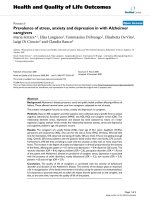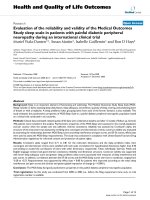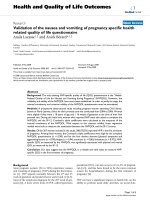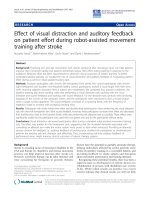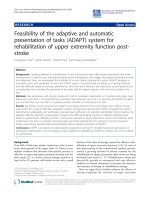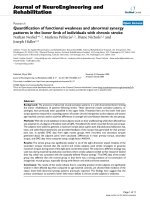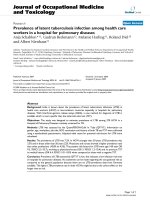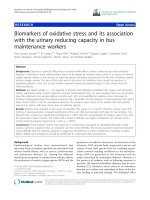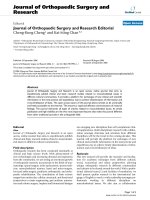Báo cáo hóa học: " Synthesis of Porous NiO and ZnO Submicro- and Nanofibers from Electrospun Polymer Fiber Templates" pptx
Bạn đang xem bản rút gọn của tài liệu. Xem và tải ngay bản đầy đủ của tài liệu tại đây (313.74 KB, 5 trang )
NANO EXPRESS
Synthesis of Porous NiO and ZnO Submicro- and Nanofibers
from Electrospun Polymer Fiber Templates
Yejun Qiu Æ Jie Yu Æ Xiaosong Zhou Æ
Cuili Tan Æ Jing Yin
Received: 17 July 2008 / Accepted: 11 November 2008 / Published online: 16 December 2008
Ó to the authors 2008
Abstract Porous nickel oxide (NiO) and zinc oxide
(ZnO) submicro- and nanofibers were synthesized by
impregnating electrospun polyacrylonitrile (PAN) fiber
templates with corresponding metal nitrate aqueous solu-
tions and subsequent calcination. The diameter of the NiO
and ZnO fibers was closely related to that of the template
fibers and larger diameters were obtained when using the
template fibers with larger diameter. SEM results showed
that the NiO and ZnO fibers have a large amount of pores
with diameters ranging from 5 nm to 20 nm and 50 nm to
100 nm, respectively. Energy dispersive X-ray (EDX)
spectra and X-ray diffraction (XRD) patterns testified that
the obtained materials were NiO and ZnO with high purity.
Keywords Nickel oxide Á Zinc oxide Á Nanofiber Á
Porous material Á Template
Introduction
Porous materials with high specific surface area (SSA) are
highly required for applications in catalysis, supercapacitors,
electromechanical actuators, and bio- and environmental
engineering [1–4]. Nanomaterials in the dimension range of
1 to 100 nm have received considerable interest because of
the unique properties different from their bulk counterparts.
Porous nanomaterials have attracted much attention in recent
years due to their hierarchical nanostructures [5–9].
Nickel oxide (NiO) is an important material extensively
used in catalysis, battery cathodes, gas sensors, electro-
chromic films, magnetic materials, and photovoltaic device
[10–15]. Improvement of the SSA of NiO nanomaterials
can greatly enhance their applications especially for cata-
lysts and supercapacitors [16–18]. Another oxide material
studied here is zinc oxide (ZnO), which is a metal oxide
semiconductor with wide bandgap of 3.37 eV and high
exciton binding energy of 60 meV, and it possesses unique
optical, acoustical, and electronic properties that stimulate
wide research interest in blue light-emitting diodes (LEDs),
field-effect transistors (FET), ultraviolet laser diodes (LD),
chemical sensors, acousto-electrical devices, catalysts, and
dye-sensitized solar cells [19–22]. Increase of the SSA of
ZnO nanomaterials benefits the improvement of its optical
property [23] and sensing response [24], etc.
In this work, we developed a novel approach to syn-
thesize porous NiO and ZnO submicro- and nanofibers by
impregnating electrospun polyacrylonitrile (PAN) fiber
templates with corresponding nitrates aqueous solution and
subsequent calcination. This method is very simple and
possibly applicable for preparing porous submicro- and
nanofibers of other metal oxide materials.
Experimental
Polyacrylonitrile (PAN, M
w
= 150,000) purchased from
Aldrich was used to prepare the fiber templates. The
electrospinning solutions were prepared by dissolving PAN
in dimethylformamide (DMF) solvent at the mass con-
centration of 11 and 14%. The electrospinning process
was carried out at the voltage of 20 kV, where aluminum
foils were used as the collectors. The collected PAN fibers
were pretreated at 250 °C for 2 h in air for stabilization.
Y. Qiu Á J. Yu (&) Á X. Zhou Á C. Tan Á J. Yin
Department of Materials Science and Engineering, Shenzhen
Graduate School, Harbin Institute of Technology, Xili,
Shenzhen 518055, China
e-mail: ;
123
Nanoscale Res Lett (2009) 4:173–177
DOI 10.1007/s11671-008-9221-6
About 50 mg stabilized PAN fiber templates were
impregnated with 10 mL Ni(NO
3
)
2
or Zn(NO
3
)
2
aqueous
solution at desired concentrations. Then the samples were
impregnated with 10 mL 0.1 M ammonia solution. After
drying in air, the samples were heated from room tem-
perature to 700 °C in air at a heating rate of 10 K/min and
maintained for 1 h in air.
X-ray diffraction (XRD) pattern was recorded with a
XD–2 diffractometer (Beijing Purkinje General Instrument
Co., Ltd.) to identify the phase of the samples. The mor-
phological features of the samples were characterized with
a HITACHI S-4700 scanning electron microscopy (SEM),
and their components were determined by an energy dis-
persion X-ray spectroscope (EDX) (EDAX company)
equipped in the SEM system.
Results and Discussion
Figure 1 shows the SEM images of the electrospun PAN
fibers prepared at the solution concentrations of 11 and
14%. The diameter of the PAN fibers is strongly
dependant on the solution concentration with it in the
range of 310–410 nm (Fig. 1a) at the former concentra-
tion and 850–1050 nm (Fig. 1b) at the latter
concentration. The diameter increase of the electrospun
fibers with solution concentration is due to the resultant
increase in solution viscosity, which has been repeatedly
reported previously [25, 26].
Figure 2 gives the SEM images of the NiO (a–c) and ZnO
(d–f) products at different magnifications. Both products
exhibit fibrous morphology. The diameter of the NiO and
ZnO fibers ranges from 80 to 130 nm and 400 to 750 nm,
respectively. The template fibers used for preparing the NiO
and ZnO fibers were electrospun at the solution concentra-
tions of 11 and 14%, respectively. As the above stated, the
PAN fibers electrospun at the concentration of 11% is much
smaller than that electrospun at 14% (Fig. 1). So the
diameter difference of the NiO and ZnO fibers originates
from that of their respective template fibers. It is observed
that the NiO nanofibers are composed of many nanoparticles
with diameter in the range of 20 to 35 nm, and the ZnO
submicrofibers are composed of many nanocrystallites with
a width of about 65 nm and length of about 200 nm. Inter-
estingly, both the NiO and ZnO fibers exhibit porous
morphology with pore size in the range of 20 to 35 nm for
the former and 50 to 100 nm for the later (Fig. 2).
Besides the diameter of the PAN template fibers, the
concentration of the impregnating solutions (Ni(NO
3
)
2
and Zn(NO
3
)
2
) is also important in affecting the diameter
of the product fibers. Different concentrations of 0.6, 1.0,
and 3.0% for the nickel nitrate solutions were investi-
gated for preparing the NiO fibers, where the PAN fibers
prepared at the PAN/DMF solution concentration of 11%
were used as the templates. The SEM images of these
three samples are shown in Figs. 3a, 2a–c, and 3b,
respectively. With decreasing the concentration of the
nickel nitrate solution from 3.0% to 0.6%, the diameter
of the NiO nanofibers decreases from about 210 to about
80 nm, while the pores in the NiO nanofibers show no
obvious changes.
Figure 4 shows the typical EDX spectra of the NiO
and ZnO fibers. For the spectrum of the NiO fibers only
nickel and oxygen were observed (Fig. 4a) and for the
ZnO fibers only zinc and oxygen were observed (Fig. 4b).
Furthermore, the atomic ratios of nickel/oxygen in the
NiO fibers and zinc/oxygen in the ZnO fibers are near to
the theoretical ratio of NiO and ZnO of 1:1. The XRD
patterns of the NiO and ZnO fibers are presented in
Fig. 5a and b, respectively. The well-defined diffraction
peaks at about 37.6, 43.7, 63.4, 75.7, and 79.8° are
observed in Fig. 5a, corresponding to the (111), (200),
(220), (311), and (222) planes of cubic NiO crystals [14],
respectively. The peak positions of the XRD pattern of
the ZnO fibers (Fig. 5b) are in good agreement with
those of the hexagonal ZnO with lattice constants
Fig. 1 SEM images of the electrospun PAN fibers prepared using
different concentration of PAN/DMF solution: 11% (a); 14% (b)
174 Nanoscale Res Lett (2009) 4:173–177
123
a = 0.3250 nm and c = 0.5207 nm [27]. The above EDX
and XRD results testify that the obtained products are
NiO and ZnO with high purity, respectively.
Many literatures reported that the products with tubular
structures could be obtained when calcinating the polymer
fiber templates coated with a shell layer of inorganic pre-
cursors [28, 29]. However, some researchers also pointed
out that the shell layer of the inorganic precursors would
shrink or collapse if the process of removing the templates
could not be well controlled [30]. The phenomenon of
shrinkage of the shell layers without forming tubular
structures provides us a simple and easy approach to fab-
ricate fibrous materials. The reason for the formation of the
NiO and ZnO fibers rather than tubes mainly lies in that the
precursor NiO and ZnO shell layers coated on the surface
of the PAN template fibers shrink accompanying with the
removal of the PAN fibers maybe driven by external
Fig. 2 SEM images of the two products: NiO (a), (b), and (c); ZnO (d), (e), and (f)
Fig. 3 SEM images of the NiO nanofibers prepared using different
concentrations of nickel nitrate solution: 0.6% (a); 3.0% (b)
Fig. 4 EDX spectra of the NiO fibers (a) and ZnO fibers (b)
Nanoscale Res Lett (2009) 4:173–177 175
123
pressure and the cohesion between the nanoparticles. To
promote the shrinkage of the shell layers, low concentra-
tion of nitrate precursor solution and high temperature
heating rate were adopted. The adoption of low concen-
tration of precursor solution results in the small thickness
of the coating layer and thus low self-supporting strength.
In this case the shell layers are prone to shrink under
external pressure during removal of the core templates. The
adoption of high heating rate of 10 K/min results in rapid
oxidation of the PAN fiber templates and release of a large
amount of gases during short time, which generates certain
pressure difference between the exterior and interior of the
fibers. If this pressure difference is higher than the critical
pressure beyond which the shell loses its stability, the shell
layer would shrink [31], and thus products with solid
structure are obtained.
The PAN fiber templates were removed through
decomposition, carbonization, and oxidation due to reac-
tion with O
2
in air [32], which generated a large amount of
gas products. The release of these gases from the core of
the impregnated fibers to the outside could produce a large
number of pores in the residual materials [33, 34].
Although using the same amount of nickel nitrate and zinc
nitrate precursors, the NiO fibers have much smaller
diameter than the ZnO fibers (Fig. 2), strongly suggesting
that the structure of the ZnO fibers is less compact. This is
in agreement with the observation that the pore size of ZnO
fibers is larger. Furthermore, the more porous structure of
ZnO fibers results in their poorer mechanical strength, and
thus the ZnO fibers are prone to break. Therefore, it is vital
to carefully control the procedure of removing the polymer
fiber templates for fabricating long, continuous, and porous
metal oxide submicro- and nanofibers.
Conclusion
In conclusion, porous NiO and ZnO submicro- and
nanofibers were prepared by using electrospun polyacry-
lonitrile fibers as templates. The products were obtained by
impregnating the electrospun fibrous webs with nickel and
zinc nitrate aqueous solution followed by calcination in air.
The diameter of the NiO and ZnO fibers is strongly
dependant on that of the template fibers and tends to be
larger when using the templates with larger diameter. SEM
showed that the NiO and ZnO fibers have many pores with
diameter in the ranges of 5 to 20 nm and 50 to 100 nm,
respectively. The EDX and XRD results testified that the
obtained products are NiO and ZnO with high purity. We
expect that the procedure of removing the polymer tem-
plate fibers play key roles in the structure formation of the
products. This method is very simple and possibly appli-
cable for preparing porous submicro- and nanofibers of
other oxide materials.
Acknowledgments This work was supported by the NSFC (Grant
No. 50572019), Program for New Century Excellent Talents in
University (NCET), SRF for ROCS, SEM, and S&T Program of
Shenzhen government.
References
1. S. Kameoka, A.P. Tsai, Catal. Lett. 121, 337 (2008). doi:
10.1007/s10562-007-9344-x
2. V.D. Patake, C.D. Lokhande, Appl. Surf. Sci. 254, 2820 (2008).
doi:10.1016/j.apsusc.2007.10.044
3. S.T. Wang, Y.G. Zhang, W.Z. Wang, G.L. Li, X.C. Ma, X.B. Li,
Z.D. Zhang, Y.T. Qian, J. Cryst. Growth 290, 96 (2006)
4. Y. Wang, X. Jiang, Y. Xia, J. Am. Chem. Soc. 125, 16176 (2003).
doi:10.1021/ja037743f
5. N. Du, H. Zhang, B.D. Chen, J.B. Wu, X.Y. Ma, Z.H. Liu, Y.Q.
Zhang, D.R. Yang, X.H. Huang, J.P. Tu, Adv. Mater. 19, 4505
(2007). doi:10.1002/adma.200602513
6. A.C. Patel, S.X. Li, J.M. Yuan, Y. Wei, Nano Lett. 6, 1042
(2006). doi:10.1021/nl0604560
7. M. Pe
´
rez-Cabero, F.R. Garcı
´
a-Garcı
´
a, D. Vie, I. Rodrı
´
guez-
Ramos, D. Beltra
´
n, P. Amoro
´
s, Mater. Lett. 62, 2935 (2008). doi:
10.1016/j.matlet.2008.01.079
8. D.Y. Ding, Z. Chen, C. Lu, Sens. Actuators B 120, 182 (2006).
doi:10.1016/j.snb.2006.02.007
9. S. Bhattacharyya, A. Gedanken, Microporous Mesoporous Mater.
110, 553 (2008). doi:10.1016/j.micromeso.2007.06.053
10. T.L. Lai, C.C. Lee, G.L. Huang, Y.Y. Shu, C.B. Wang, Appl.
Catal. B 78, 151 (2008). doi:10.1016/j.apcatb.2007.09.015
11. H.X. Yang, D.F. Dong, X.H. Hu, J. Power Sources 79, 256
(1999). doi:10.1016/S0378-7753(99)00158-5
12. I. Hotovy, J. Huran, L. Spiess, S. Hascik, V. Rehacek, Sens.
Actuators B 57, 147 (1999). doi:10.1016/S0925-4005(99)00077-5
13. J.L. Garcia-Miquel, Q. Zhang, S.J. Allen, A. Rougier, A. Blyr,
H.O. Davies, A.C. Jones, T.J. Leedham, P.A. Williams, S.A.
Impey, Thin Solid Films 424, 165 (2003). doi:10.1016/S0040-
6090(02)01041-6
14. T. Ahmad, K.V. Ramanujachary, S.E. Lofland, A.K. Ganguli,
Solid State Sci. 8, 425 (2006). doi:10.1016/j.solidstatesciences.
2005.12.005
Fig. 5 XRD patterns of the NiO fibers (a) and ZnO fibers (b)
176 Nanoscale Res Lett (2009) 4:173–177
123
15. M. Borgstrom, E. Blart, G. Boschloo, E. Mukhtar, A. Hagfeldt,
L. Hammarstrom, F. Odobel, J. Phys. Chem. B 109, 22928
(2005). doi:10.1021/jp054034a
16. X.Y. Chen, Z.G. Zhang, C.W. Shi, X.L. Li, Mater. Lett. 62, 346
(2008). doi:10.1016/j.matlet.2007.05.030
17. X.H. Xia, J.P. Tu, J. Zhang, X.L. Wang, W.K. Zhang, H. Huang,
Sol. Energy Mater. Sol. Cells 92, 628 (2008). doi:10.1016/
j.solmat.2008.01.009
18. G. O
¨
zkan, E. O
¨
zc¸elik, J. Power Sources 140, 28 (2005). doi:
10.1016/j.jpowsour.2004.08.008
19. N. Hongsith, C. Viriyaworasakul, P. Mangkorntong, N. Mangk-
orntong, S. Choopun, Ceram. Int. 34, 823 (2008). doi:10.1016/
j.ceramint.2007.09.099
20. Y. Xia, P. Yang, Y. Sun, Y. Wu, B. Mayers, B. Gates, Y. Yin,
F. Kim, H. Yan, Adv. Mater. 15, 353 (2003). doi:10.1002/adma.
200390087
21. M.H. Huang, S. Mao, H. Feick, H. Yan, Y. Wu, H. Kind,
E. Weber, R. Russo, P. Yang, Science 292, 1897 (2001). doi:
10.1126/science.1060367
22. M.L. Kantam, K.B.S. Kumar, C. Sridhar, Adv. Synth. Catal. 347,
1212 (2005). doi:10.1002/adsc.200505011
23. S.H. Lee, H.J. Lee, H. Goto, M.W. Cho, T. Yao, Phys. Status
Solidi C 4, 1747 (2007). doi:10.1002/pssc.200674279
24. V.R. Shinde, T.P. Gujar, C.D. Lokhande, Sens. Actuators B 123,
701 (2007). doi:10.1016/j.snb.2006.10.003
25. J. Yu, Y.J. Qiu, X.X. Zha, M. Yu, J.L. Yu, J. Rafique, J. Yin, Eur.
Polym. J. 44, 2838 (2008). doi:10.1016/j.eurpolymj.2008.05.020
26. J.M. Deitzel, J. Kleinmeyer, D. Harris, N.C.B. Tan, Polymer
(Guildf) 42, 261 (2001). doi:10.1016/S0032-3861(00)00250-0
27. J.Y. Li, X.L. Chen, H. Li, M. He, Z.Y. Qiao, J. Cryst. Growth
233, 5 (2001). doi:10.1016/S0022-0248(01)01509-3
28. F. Ochanda, W.E. Jones, Langmuir 21, 10791 (2005). doi:
10.1021/la050911s
29. M. Bognitzki, H.Q. Hou, M. Ishaque, T. Frese, M. Hellwig, C.
Schwarte, A. Schaper, J.H. Wendorff, A. Greiner, Adv. Mater.
12, 637 (2000). doi:10.1002/(SICI)1521-4095(200005)12:9\637
::AID-ADMA637[3.0.CO;2-W
30. Z. Li, X.F. Qian, J. Yin, Z.K. Zhu, J. Solid State Chem. 178, 1765
(2005). doi:10.1016/j.jssc.2005.03.033
31. L.Q. Ge, X. Wang, Z.C. Tu, C. Pan, C. Wang, Z.Z. Gu, Jpn. J.
Appl. Phys. 46, 6790 (2007). doi:10.1143/JJAP.46.6790
32. H. Yan, C.F. Blanford, B.T. Holland, W.H. Smyrl, A. Stein,
Chem. Mater. 12, 1134 (2000). doi:10.1021/cm9907763
33. H.X. Niu, Q. Yang, K.B. Tang, Y. Xie, Microporous Mesoporous
Mater.
96, 428 (2006). doi:10.1016/j.micromeso.2006.07.013
34. J. Liu, D.F. Xue, Adv. Mater. 20, 2622 (2008). doi:10.1002/
adma.200800208
Nanoscale Res Lett (2009) 4:173–177 177
123

